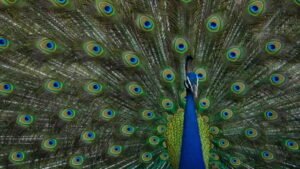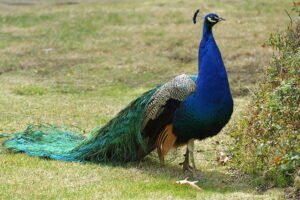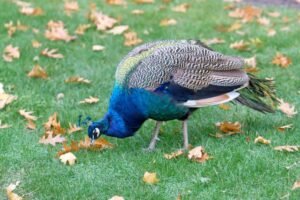
The lifespan of peacocks, renowned for their dazzling plumage and flashy displays, is a subject that captivates both nature enthusiasts and curious minds alike. “How Long do Peacocks Live” explores the intricacies of these majestic birds’ life expectancy, unraveling a tapestry of biological factors and environmental influences that shape their longevity. As symbols of grace and beauty, peacocks have long been fixtures in mythology, art, and cultural symbolism, adding an extra layer of fascination to the inquiry into their lifespan.
To comprehend the duration of a peacock’s life, one must delve into the biological nuances of their species, examining the interplay between genetics, environmental conditions, and the challenges they face in the wild. From the vividly adorned Indian Peafowl to the subtly elegant Green Peafowl, variations in species may yield different lifespans, offering a rich diversity of insights into their respective life cycles.
Furthermore, the exploration extends beyond mere numerical figures, venturing into the behavioral patterns, mating rituals, and survival strategies that impact a peacock’s journey through life. From the vibrancy of their courtship displays to the intricacies of raising their young, a peacock’s lifespan is a tapestry woven with threads of adaptation, resilience, and the perpetual dance with nature.
This exploration into the temporal dimensions of peacock existence not only satiates a natural curiosity but also serves as a lens through which we can better understand the delicate balance between life and its myriad influences in the avian realm. “How Long do Peacocks Live” beckons us to unravel the mystery behind these regal creatures, fostering a deeper appreciation for the marvels of the natural world.
Introduction of Peacock Life
The life of a peacock, characterized by its splendid plumage and captivating displays, unfolds as a remarkable journey in the intricate tapestry of the avian world. This introduction peels back the layers of fascination surrounding these majestic birds, setting the stage for an in-depth exploration into the duration and dynamics of a peacock’s existence.

Peacocks, members of the pheasant family, are renowned for their stunning beauty and have ingrained themselves in cultural lore as symbols of grace and luxury. As we journey to understand how long peacocks live, we must appreciate the broader context of their lives. Beyond the mere biological markers of age, the lifespan of peacocks is intertwined with a myriad of factors, from their vibrant courtship rituals to the challenges they face in the wild.
The introduction invites readers into the colorful realm of peacock life, where the ornate plumage serves as a visual spectacle and a key element in the intricate dance of courtship and survival. Exploring the depths of this avian existence requires understanding the species diversity, with variations in lifespan among different types of peafowl, including the Indian and Green Peafowl.
As we unravel the mysteries of their lifespan, it becomes apparent that the story extends far beyond the mere numerical count of years. It delves into the behaviors, adaptations, and strategies defining a peacock’s life journey. The introduction captures the essence of this exploration, teasing the reader with the promise of insights into the biological, behavioral, and ecological dimensions of peacock existence.
This preamble to the exploration of “How Long do Peacocks Live” serves as a gateway into a world where beauty meets biology and where the enchanting displays of peacocks are but a prelude to the intricate narratives of survival and adaptation. The subsequent sections will delve into the diverse facets of peacock life, unraveling the secrets that make these birds a visual spectacle and fascinating subjects of study in the natural world.
Peacock Life 1st Stage
The life cycle of a peacock begins with the arrival of delicate, fluffy chicks, marking the inception of a fascinating journey that unfolds in distinct stages. The first stage, that of baby peacocks, is characterized by vulnerability, endearing behaviors, and crucial developmental milestones.

Hatching and Early Days: The journey commences with the hatching of peacock eggs, a process that takes approximately four weeks. The fuzzy chicks emerge, covered in soft down feathers, their vibrant hues yet to unfurl. These precariously tiny chicks are often under the watchful eye of their mother, who diligently tends to their needs. The initial days are a critical adjustment period as the chicks acclimate to their surroundings and bond with their caretaker.
Feeding and Growth: During the early stages, the diet of baby peacocks primarily consists of insects, seeds, and small invertebrates. The mother plays a pivotal role in teaching them foraging skills, a process that contributes to their survival instincts. As the chicks grow, their dietary preferences expand, gradually incorporating a broader range of food sources.
Social Dynamics: Baby peacocks exhibit a charming camaraderie, often staying close to their mother for protection and warmth. The social interactions within the family unit play a crucial role in developing the chicks’ social skills. They learn essential behaviors and communication cues through observation and interaction with their siblings and mother.
Feather Development: While the iconic plumage of adult peacocks is absent during the early stages, the transformation begins as the chicks age. The initial down feathers give way to the emergence of juvenile feathers, providing a glimpse of the vibrant colors that will define their mature plumage. This gradual transformation is a testament to the intricate maturation process that unfolds over time.
Protection and Survival Instincts: In the wild, baby peacocks face various threats, including predators and environmental challenges. The mother is a vigilant protector, using her sharp instincts to guide the chicks away from potential dangers. During this stage, the development of survival instincts is crucial for the chicks to navigate the intricacies of their environment.
Human Interaction and Domestication: When peacocks are raised in captivity, human interaction becomes a significant aspect of their early days. Hand-reared chicks may form bonds with humans, showcasing adaptability that adds to their charm. However, balancing domestication and preserving their natural behaviors is crucial for their well-being.
The first stage of a peacock’s life centered around the enchanting realm of baby peacocks and lays the foundation for their subsequent development phases. From the vulnerability of hatchlings to the gradual emergence of their vibrant plumage, this initial stage is a testament to the resilience and adaptability of these captivating birds.
Peacock Life 2nd Stage
As the juvenile peacocks transition into adulthood, a magnificent transformation occurs, unveiling the full splendor of these birds. The second stage of a peacock’s life is marked by the development of their iconic plumage, intricate courtship displays, and the establishment of territories.

Plumage Development: The most striking feature of adult peacocks is their splendid plumage. The duller juvenile feathers transform remarkably, revealing the vibrant and iridescent hues that peacocks are renowned for. This process, often referred to as molting, is a testament to their genetic predisposition and plays a crucial role in courtship rituals.
Courtship Displays: Adult male peacocks, known as peafowls, engage in elaborate courtship displays to attract mates. These displays involve flaunting their dazzling plumage, rhythmic dances, and distinctive calls. The intricate patterns and colors of their feathers serve as a visual symphony, captivating the attention of peahens and signaling the readiness for mating.
Mating Rituals: The second stage of a peacock’s life is intrinsically linked with the pursuit of mates. Adult peacocks establish territories and engage in vocalizations and displays to assert dominance. The competition for mating rights is fierce, and the successful peacock gains the privilege to court and mate with peahens. Mating is a pivotal aspect of their life cycle, ensuring the continuation of their species.
Parental Responsibilities: After successful mating, peahens nest and incubate eggs. The collaborative efforts of male and female peafowls in parenting contribute to the well-being of their offspring. The attentive care displayed by adult peacocks reflects a balance between their ornate displays and their commitment to ensuring the next generation’s survival.
Territorial Behavior: Adult male peacocks establish and defend territories, creating a hierarchy based on dominance. The possession of a prime part enhances their chances of attracting mates. These territories, marked by visual displays and vocalizations, serve as arenas for courtship rituals and contribute to the overall dynamics of peacock society.
Interaction with Humans: Adult peacocks, particularly those in captivity, may display varying degrees of interaction with humans. While some retain a degree of wild behavior, others raised in more domestic settings may exhibit familiarity with human caretakers. Striking a balance between preserving their instincts and fostering a cooperative relationship is crucial for their well-being.
Longevity and Aging: The second stage of a peacock’s life encompasses the prime of their existence. The lifespan of adult peacocks varies among species, with factors such as genetics and environmental conditions influencing their longevity. Aging changes their physical shape, yet the allure of their plumage and the elegance of their displays persist, making them captivating subjects throughout their lives.
The maturation of peacocks into adulthood is a spectacle beyond mere aesthetics. It involves the intricate dance of courtship, the establishment of territories, and passing the generational torch through successful mating and parenting. In adult peacock life, the beauty of their plumage is not just a visual marvel but a manifestation of the complex interplay between biology, behavior, and the perpetuation of their species.
Peacock Life Last Stage
The final stage of a peacock’s life unfolds as a graceful twilight, marking the culmination of a journey that began with fragile hatchlings and blossomed into the resplendent adulthood of these majestic birds. This stage is characterized by the nuanced aspects of aging, the role of experience, and the enduring legacy that adult peacocks leave behind.

Aging and Physical Changes: As peacocks age, subtle changes become evident in their physical condition. The once-vibrant plumage may exhibit signs of wear, and the overall energy levels may slightly diminish. These age-related transformations, while natural, showcase the passage of time and add a layer of depth to the captivating narrative of a peacock’s life.
Experienced Wisdom: The aging process brings a wealth of experiences that contribute to the wisdom of the peacock. Having navigated the intricacies of courtship, mating, and parenting, older peacocks often exhibit a nuanced understanding of their environment. Their interactions within the social structure testify to the depth of their experiences and their role in the dynamics of peafowl society.
Legacy of Offspring: One of the most enduring aspects of the last stage of a peacock’s life is the legacy left through offspring. Successful mating and parenting contribute to the continuity of their genetic lineage, ensuring that the next generation inherits the distinctive traits and behaviors that define the species. The presence of offspring becomes a living testament to the peacock’s contribution to the perpetuation of their kind.
Social Dynamics: In the later stages of life, peacocks often find themselves in evolving social dynamics. The territories they once fiercely defended may transition to younger, more vigorous individuals. Despite potential status changes, older peacocks often play vital roles as stabilizing figures within the social hierarchy, contributing to the overall cohesion of peafowl communities.
Adaptation to Changing Conditions: The last stage of a peacock’s life involves adaptation to changing environmental conditions. Whether in the wild or captivity, factors such as climate, food availability, and human interaction play crucial roles in shaping the twilight years of these majestic birds. Their ability to adapt becomes a key determinant of their well-being and longevity.
Interaction with Humans in Aging: Aging may also involve continued interaction with human caretakers for peacocks in captivity. The relationships formed over the years contribute to the overall well-being of aging peacocks, offering companionship and care. Striking a balance between providing a supportive environment and allowing them to age gracefully becomes paramount in ensuring a fulfilling twilight stage.
Reflection on a Life Well-Lived: In the last stage of their lives, peacocks symbolize the beauty of aging gracefully. The subtle elegance of their demeanor, combined with the echoes of a life rich in experiences, paints a poignant picture of a peacock that has traversed the various stages of existence. Each feather is a testament to the vibrant chapters of courtship, parenting, and social interactions.
As we explore the last stage of a peacock’s life, we witness the convergence of age, experience, and the enduring legacy that defines these magnificent birds. Though marked by the gentle slowing of physical prowess, the twilight years shine with the brilliance of a life well-lived and the indelible mark they leave on the tapestry of peafowl existence.
Conclusion
The life of a peacock unfolds as a captivating narrative, weaving through distinct stages that encapsulate the fragility of hatchlings, the glorious beauty of adulthood, and the graceful twilight of aging. From the enchanting world of baby peacocks, where vulnerability intertwines with the promise of vibrant plumage, to the majestic maturation marked by courtship displays and territorial dynamics, the journey is a testament to the intricate dance of biology, behavior, and survival.
As peacocks advance into the last stage of their lives, their aging gracefully becomes a reflection of a life rich in experiences, leaving behind a legacy through offspring and contributing to the social fabric of peafowl communities. Through these stages, the peacock’s story transcends mere aesthetics, revealing a profound connection between the natural rhythms of life, the resilience of these magnificent birds, and the timeless allure they cast upon the canvas of the avian world.





